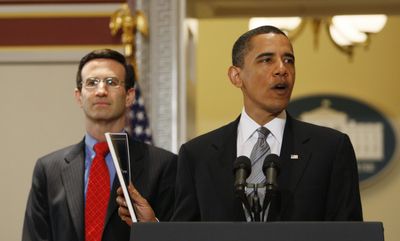President’s proposed cuts prompt party pushback
Pentagon takes biggest hit in 2010 budget proposal

WASHINGTON – President Barack Obama’s modest proposal to slice $17 billion from 121 government programs quickly ran into a buzz saw of opposition on Capitol Hill Thursday, as an array of Democratic lawmakers vowed to fight White House efforts to deprive their favorite initiatives of federal funds.
Sen. Dianne Feinstein, D-Calif., said she is “committed” to keeping a $400 million program that reimburses states for jailing illegal immigrants.
Rep. Mike Ross, D-Ark., said he would oppose “any cuts” in agriculture subsidies because “farmers and farm families depend on this federal assistance.”
And Rep. Maurice D. Hinchey, D-N.Y., vowed to force the White House to accept delivery of a new presidential helicopter Obama says he doesn’t need and doesn’t want. The helicopter program, which cost $835 million this year, supports 800 jobs in Hinchey’s district.
The flurry of news releases began flying as Obama unveiled the long-awaited details of his $3.4 trillion spending plan, including a list of programs he wants to trim or eliminate. Though the proposed reductions represent just one-half of 1 percent of next year’s budget, the swift protest was a precursor of the battle Obama will face within his own party to control spending and rein in a budget deficit projected to exceed $1.2 trillion next year.
As small as it is, the list of reductions highlights Obama’s first effort to reshape priorities that were tilted heavily toward defense and national security under President George W. Bush. While the Pentagon would get a significant increase overall, more than half Obama’s projected savings – $8.8 billion – would come out of 14 defense programs, the most from any agency. And, for the first time since 2003, the budget would devote more money to the war in Afghanistan than to the one in Iraq.
White House budget director Peter Orszag said he realizes that “this is a cooperative process with Congress,” and that he has been “heartened by meetings with lawmakers, who are also actively seeking a variety of savings.”
The budget documents released Thursday total more than 1,500 pages and fill in details of the broad outline that Obama released in February and that Congress approved last week.
The volume of cuts is weighted heavily toward the Pentagon, where Obama is asking Congress to cancel seven programs and to reduce seven others.
At Homeland Security, the massive agency Bush created in his first term, Obama is proposing to cut four programs, totaling $90 million, including a $35 million grant program that pays for local emergency operations centers. Obama argues that Congress has earmarked more than half the money in previous years for pet projects, rather than distributing merit-based grants.
Obama also would eliminate new spending to buy advanced-generation sensors to detect nuclear bombs or radioactive materials at U.S. ports and borders, a Bush priority that has had technical problems.
Meanwhile, in a shift on immigration policy, Obama would boost spending at Homeland Security by $206 million to speed processing of immigration cases for refugees, asylum seekers and members of the U.S. military applying for citizenship.
On another sensitive social issue, the White House wants to eliminate two abstinence-only sex-education programs totaling $145 million. Instead, the budget calls for the creation of a new initiative to combat teen pregnancy that would rely on funding from those programs.
Administration officials said 75 percent of funds from the new initiative would be reserved for programs with a record of pregnancy prevention, with the rest available for unproven but “promising models.” Abstinence programs could continue to receive funding under the latter category, they said.